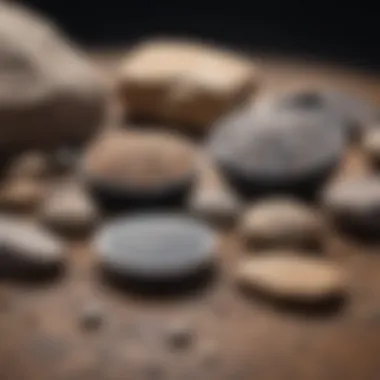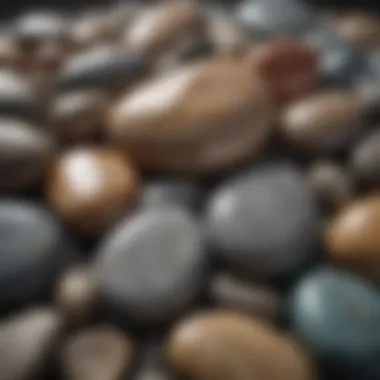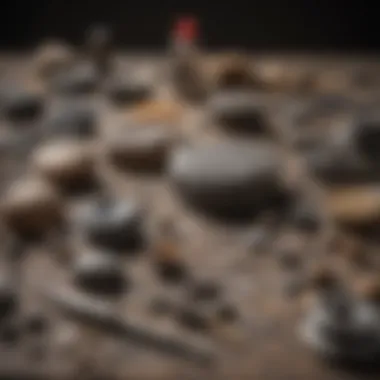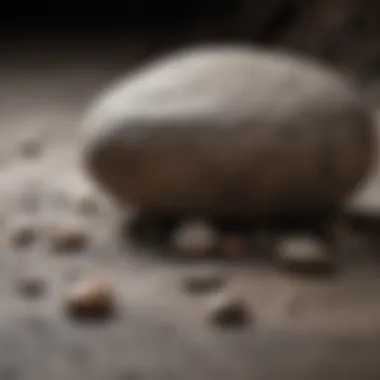A Comprehensive Guide to Rock Polishing Kits


Intro
Rock polishing is not merely a hobby but an art form that captures the beauty of nature. Enthusiasts dedicate time to refine rough stones into shiny, smooth pieces. This process not only enhances their aesthetic value but also brings joy to those who appreciate the intricacies and uniqueness of earth's creations. A significant part of this journey lies in the use of rock polishing kits, which provide the tools necessary for crafting stunning specimens.
Topic Overview
Definition of the collectible rock
Specialty collectibles like rocks and minerals are defined by their unique characteristics and natural origins. Collectors often seek these items for their beauty, rarity, or historical significance. The act of polishing these stones elevates their appeal, showcasing their inherent colors and patterns.
Brief history and significance
The practice of rock polishing has deep historical roots, dating back centuries. Ancient civilizations recognized the allure of shiny stones, using them in jewelry and trade. Throughout history, various cultures have celebrated the aesthetic and cultural value of polished rocks. Today, modern technology allows hobbyists and professional collectors to achieve results previously unimaginable.
"Rock polishing transforms raw materials into alluring pieces, preserving geological stories within them."
Identification and Classification
How to categorize items
Collectors often categorize rocks and minerals based on several criteria:
- Type of rock: igneous, sedimentary, or metamorphic.
- Color: hues and shades can classify many varieties.
- Texture: smooth, rough, or crystalline surfaces lend insights into each rock's identity.
Tips for identifying key features
Recognizing the distinct features of rocks can enhance collection quality. Here are some tips:
- Examine the luster (shine) of the rock. It can indicate the mineral content.
- Check the hardness using a simple scratch test with a common material, like a fingernail or a penny.
- Observe any veins or patterns, which can signal specific geological formations.
By understanding these elements, collectors can make informed decisions about their polishing processes and the kits best suited for their needs.
Understanding Rock Polishing
Rock polishing is a craft and hobby that appeals to many individuals, especially those with an interest in geology and natural beauty. This section outlines why understanding the nuances of rock polishing is essential. It delves into the benefits of this practice, including how it enhances the aesthetic appeal of stones and helps collectors appreciate their pieces more deeply.
One significant aspect of understanding rock polishing is recognizing its transformative power. Unfinished stones, often rough and unappealing, can be turned into objects of beauty. The process itself can be meditative, allowing enthusiasts to engage with the materials they love on a deeper level. Additionally, knowing the fundamentals can save time and resources in the long run.
When starting on this journey, it is vital to familiarize oneself with the equipment and techniques involved. This knowledge can help prevent damages to the stones or improper usage of the polishing kit. In short, understanding rock polishing lays the groundwork for a rewarding and enriching hobby.
The Basics of Rock Polishing
The basic premise of rock polishing involves a sequence of steps to refine rough stones into smooth, glossy surfaces. First, raw stones should be selected with careful consideration of their hardness and composition. The process begins with grinding to remove imperfections, gradually using finer grits until the desired fineness is reached. The final polishing stage uses specially formulated compounds, which can bring a brilliant shine to any rock.
This process requires a combination of tools, such as a polishing machine, various grades of stones, and polishing compounds. Collectors learn to appreciate the patience needed, as well-polished stones often take several weeks to achieve the desired finish. The combination of techniques and tools makes this activity both an art and a science.
Historical Context
The practice of polishing stones dates back thousands of years. Ancient civilizations used simple methods to bring out the beauty of natural minerals. They developed rudimentary polishing techniques, often using abrasive materials found in their environment. Notably, some of the earliest polished stones were used in jewelry, showing that the desire to enhance stone aesthetics is enduring.
Through history, polishing has evolved significantly. With advancements in technology and the introduction of specialized equipment, the process became more efficient and accessible. Today, hobbyists can find kits designed for various skill levels, making it possible for anyone to start polishing rocks at home. The rich history of this craft not only reflects human creativity but also the ongoing fascination with natural beauty.
Components of a Rock Polishing Kit
Understanding the components of a rock polishing kit is essential for anyone looking to achieve successful results in their polishing endeavors. Each of the components serves a unique purpose, playing a critical role in the polishing process. These elements not only contribute to the end result but also enhance the overall user experience, making it enjoyable and productive.
Essential Tools
Polishing Machine
The polishing machine is at the core of any rock polishing kit. It is designed to perform the labor-intensive task of shaping and polishing rocks. One high-quality example is the Lortone LAPidary Tumbler, which is recognized for its durability and efficiency.
A key characteristic of polishing machines is their ability to operate at varying speeds. This feature allows users to adjust the machine according to the type of rock they are working on. Generally, machines with a higher capacity can handle larger loads, making them popular choices among enthusiasts.


The Lortone LAPidary Tumbler is beneficial because it provides a smooth and consistent finish, which is essential for showcasing polished stones. However, it does have some disadvantages; the initial cost can be relatively high, and it requires careful maintenance to keep it functioning effectively.
Grading Stones
Grading stones are just as critical as the polishing machine. They serve to smooth out the rough edges of rocks before the final polishing stage. Common examples include silicon carbide and alumina oxide grading stones.
A significant aspect of grading stones is their grit, which plays a vital role in how effectively they can shape stones. For instance, coarser grading stones remove material quickly, allowing faster shaping. This feature is particularly beneficial for larger or rougher rocks. However, when using them, it is important to progress through different grit levels carefully, as skipping grits can produce unfavorable results in the final polish.
Polishing Compounds
Polishing compounds are another essential component, providing the final touch to achieve a high luster on rocks. Popular compounds include cerium oxide and tin oxide.
A key characteristic of polishing compounds is their fine abrasiveness, which can effectively remove micro-scratches from the rock surfaces. This aspect makes them a popular choice for collectors and enthusiasts who aim for that brilliant finish.
Each type of compound has its unique feature; for example, cerium oxide is particularly suitable for removing fine scratches on quartz and glassy stones, enhancing their appearance significantly. However, polishing compounds may require more frequent replacement, depending on usage, which can add to the overall cost of maintaining a rock polishing kit.
Optional Accessories
While the essential tools form the backbone of a rock polishing kit, optional accessories can enhance safety and efficiency. Including accessories in your polishing routine can improve the overall experience and the results.
Safety Gear
Safety gear should not be overlooked, as polishing rocks can produce dust and small particles that may be harmful if inhaled or come into contact with skin. Essential safety gear includes dust masks, goggles, and gloves.
The key characteristic of safety gear is that it provides necessary protection against harmful particles produced during polishing. This makes it a beneficial and practical inclusion in any polishing kit. Unique features like adjustable straps on face masks and anti-fog coatings on goggles increase user comfort and effectiveness. However, it's worth noting that some users might prioritize convenience over safety and skip using them.
Cleaning Supplies
Cleaning supplies are important for maintaining the tools and workspace. Suitable cleaning agents, brushes, and towels can remove dust and residue from both the rocks and the polishing equipment.
Their main contribution is ensuring that the components remain in good condition, thus prolonging their lifespan. The unique feature of quality cleaning agents is their non-abrasiveness, ensuring that the polished stones retain their luster. The downside is that users must remember to clean regularly to avoid buildup that could interfere with the polishing process.
Storage Containers
Storage containers are also essential for organizing the various components of the rock polishing kit. They help keep everything in one place, from the polishing machine to the polishing compounds.
A key characteristic of durable storage containers is their ability to protect the tools from damage during transport or storage. They can also help prevent contamination among different polishing media. However, poorly designed containers may not offer adequate protection, leading to potential damage and inefficiencies during the polishing process.
Types of Rock Polishing Kits
Understanding the different types of rock polishing kits is crucial for both enthusiasts and collectors. Each type caters to various skill levels and specific needs, so selecting appropriately can significantly impact the results of your polishing efforts. A well-suited kit not only enhances the quality of polished stones but also makes the process enjoyable. Selecting the right kit allows individuals to customize their approach based on their goals, whether they aim for basic polishing or advanced techniques.
Beginner Kits
Beginner kits are ideal for those who are just starting their journey into rock polishing. These kits typically include all the necessary tools and materials for a straightforward polishing process. A basic polishing machine, assorted grit compounds, and clear instructions are usually part of the package.
These kits are designed with simplicity in mind, allowing new users to familiarize themselves with the basics without becoming overwhelmed by advanced techniques. The advantages include:
- Ease of Use: User-friendly machines and clear guidelines that simplify the process.
- Affordability: Lower cost compared to professional kits, making it accessible for hobbyists.
However, users should note that beginner kits might have limitations regarding the types of rocks that can be polished and the final quality of the stones. A beginner might find that as their skills improve, they may want to invest in more advanced options.
Advanced Kits
Advanced kits cater to experienced hobbyists who seek to refine their polishing techniques. These kits often feature high-quality polishing machines, more extensive grit selections, and specialized compounds designed for different types of stones.
Investors in advanced kits will benefit from:
- Enhanced Quality: Superior polishing results with professional-grade materials and tools.
- Versatility: Capability to work on a wider variety of rock types, including harder stones.
Advanced kits may also offer adjustable settings and additional features, allowing for greater control over the polishing process. Those who have mastered basic techniques will appreciate the depth these kits provide, encouraging ongoing exploration and refinement of skills.
Customizable Options


Customizable kits provide hobbyists the freedom to create a setup that precisely meets their needs. Users can handpick components such as machines, polishing compounds, and safety gear to tailor their polishing experience.
The benefits of customizable options include:
- Personalization: Build a kit that suits personal preferences, specific rock types, and polishing goals.
- Future Growth: As skills develop, users can continue to add tools and materials without needing a complete kit overhaul.
These options are ideal for serious collectors and professionals who understand their requirements and wish to maximize their efficiency and effectiveness. This flexibility supports every step of the polishing process, allowing individuals to explore unique combinations that might yield exceptional results.
Selecting the Right Kit
Choosing the correct rock polishing kit is a critical decision for anyone interested in developing their hobby or craft. This selection process influences the quality of the polishing results and the overall enjoyment of the activity. By understanding the various factors at play, one can make an informed choice that aligns with personal needs and goals.
Factors to Consider
Skill Level
Understanding skill level is essential when choosing a rock polishing kit. Beginners may benefit from kits that are designed with user-friendliness in mind. Such kits often contain simplified instructions and essential components that are easy to understand. For instance, a kit that comes with pre-measured polishing compounds can be very helpful.
Conversely, advanced users might prefer more versatile kits that allow for customization. These kits typically offer a range of grades for polishing, allowing experienced hobbyists to experiment with different rocks. However, this can complicate the polishing process for those who are not as familiar with the necessary techniques. Therefore, selecting a kit that matches one’s skill level ensures a smoother experience and better results.
Type of Rocks
The type of rocks one plans to polish plays a significant role in choosing the right kit. Different rocks have unique properties that require specific polishing techniques. For example, softer stones like calcite may not need a robust polishing machine; a more straightforward setup is enough.
On the other hand, harder stones such as quartz or agate might require more advanced tools to achieve a desirable finish. Therefore, knowing the types of rocks you will be working with helps narrow down your options and ensures that the kit you select will effectively cater to those materials.
Budget
Budget considerations are vital when selecting a rock polishing kit. Prices for these kits vary widely, often depending on the brand and the included components. A lower budget can still offer several options, but it is essential to ensure that the quality isn’t compromised.
Investing in a slightly more expensive kit can pay off in better durability and results. For those on a tighter budget, it’s useful to consider kits that offer essential features without unnecessary extras. This approach will help to make the most of available resources while still achieving satisfactory polishing results.
Comparing Brands
The variety of brands available in the market can make it challenging to decide on a suitable rock polishing kit. Each brand typically has its strengths and weaknesses. Some brands may be known for their quality components, while others might stand out for their affordability.
Conducting a thorough comparison of customer reviews and ratings can provide significant insight into which brand aligns with your expectations. Features such as warranty, customer support, and availability of replacement parts also add value to your choice and should not be overlooked.
When making a selection, it’s beneficial to weigh these factors against your specific requirements as a rock polishing enthusiast.
Rock Polishing Techniques
Rock polishing is a meticulous process that significantly influences the final appearance of the stones. Understanding the various techniques involved is crucial for both new and experienced collectors aiming to enhance the aesthetic appeal of their mineral specimens. Each technique addresses specific needs and challenges associated with the polishing process, ensuring that the rocks emerge with the desired sheen and clarity.
Pre-Polishing Preparation
Before engaging in the polishing process, proper preparation is essential. This initial stage lays the foundation for the subsequent polishing phases.
- Selecting Rocks Wisely: Choose rocks that are suitable for polishing. Some stones, like agate or quartz, respond well to polishing, while others may not yield satisfactory results.
- Cleaning Rocks Thoroughly: It is vital to clean the rocks before beginning. Remove dirt, mud, and any other contaminants. Surface impurities can hinder the polishing process and affect the final result.
- Inspecting for Damages: Examine the stones for any cracks or structural issues. Rocks with flaws may require special care during polishing to avoid further damages.
- Safety Preparation: Use proper safety gear, like gloves and goggles, to protect against particles released during polishing.
This preparatory phase is not just routine; it is a key determinant in achieving high-quality results.
Different Polishing Stages
The polishing process typically consists of several distinct stages, each serving a specific purpose in transforming rough stones into gleaming pieces.
- Coarse Grinding: Starts with coarse grit to shape the stones. This step removes rough edges and prepares the surface for finer polishing.
- Medium Grinding: In this stage, finer grits are used to refine the shape and further smooth the surface. The goal is to remove scratches made during coarse grinding.
- Fine Polishing: This step employs the finest grits or polishing powders. It enhances the surface shine and brings out the stone's natural beauty.
- Buffing: Sometimes, a buffing wheel or softer materials are used to give the rocks an even higher gloss. This final step adds a protective layer and maximizes visual appeal.
Each stage is equally important. Skipping stages can result in subpar outcomes.
Troubleshooting Common Issues
Despite careful planning and execution, issues may arise during the polishing process. Knowing how to address these common challenges can save time and material.


- Under-polished Stones: If stones do not shine as expected, they may require more time in the final polishing stage. Consider using a different polishing compound or increasing the polishing time.
- Scratches Appearing: A surface that still shows scratches after polishing may indicate insufficient or inconsistent grinding. Revisit earlier stages to ensure thorough processing.
- Hazy Appearance: A hazy finish can result from inadequate cleaning at the beginning. Ensure stones are clean before polishing and that no residual material remains.
The key to successful rock polishing lies in understanding and adapting techniques to individual stones. Every rock is different, and flexibility in technique can lead to better outcomes.
Being aware of these challenges and having strategies in place to overcome them can significantly enhance the polishing experience. The successful execution of these techniques results not only in beautiful polished stones but also in greater satisfaction with the entire process.
Best Practices for Maintenance
In the realm of rock polishing, maintenance of your tools and equipment plays a crucial role in achieving top-quality results. Adopting best practices not only enhances the lifespan of your materials but also ensures that your polished stones meet your expectations. Regular upkeep strategies can significantly streamline your process, keeping your kit ready for use at all times. This section will explore practical tips on cleaning, storage, and maintaining your rock polishing kit.
Cleaning and Storage
Proper cleaning and storage of your polishing equipment are fundamental for consistent performance. After each use, it is essential to thoroughly clean your polishing machine and tools. Dust, grit, and residue from polishing compounds can accumulate and lead to poor outcomes in future sessions. Using a soft cloth or brush can help you easily clear away debris.
Here are some key steps:
- Clean the polishing machine: Use a damp cloth to wipe the exterior and a soft brush to remove debris from the base.
- Rinse grading stones: Ensure that any grading stones are rinsed gently and dried completely before storage.
- Organize polishing compounds: Store these in airtight containers to prevent moisture absorption.
Proper storage will also protect your components from excess wear. Keeping the entire kit in a dry, clean environment will minimize the risk of damage. Use specialized boxes or bins that can separate different elements to avoid unwanted contact.
"Proper maintenance not only extends the life of your rock polishing kit but also enhances the quality of your work."
Replacing Worn Components
Eventually, certain parts of your rock polishing kit will show signs of wear. Knowing when and how to replace these components is essential for maintaining optimal performance. Continue monitoring grading stones, polishing wheels, and compounds for signs of depletion.
Here are some considerations:
- Check for visible damage: Examine polishing wheels for cracks or uneven wear, which can affect the final finish.
- Monitor performance: If you notice a decline in polishing efficiency, it might be time to replace the compounds or stones.
- Follow manufacturer's guidelines: Consult the product specifications. Brands often provide details on how frequently parts should be replaced and the optimal usage conditions.
By adhering to these best practices, you not only enhance the quality of your work but also prolong the life of your rock polishing kit. This conscientious approach to maintenance will serve any collector or enthusiast well, ensuring that their hobby remains enjoyable and productive.
Understanding Results
In the realm of rock polishing, achieving desired outcomes is a blend of art and science. This section focuses on understanding the results of your polishing efforts. The importance of evaluating polished stones cannot be overstated. It gives insight into the effectiveness of techniques used and the quality of the final product.
Evaluating Polished Stones
When evaluating polished stones, several factors come into play. The clarity and luster of the stones are key indicators of a successful polishing process. Beginners may find the difference between unpolished and polished stones astounding. A well-polished stone will exhibit a smooth surface and enhanced color vibrancy. Factors to consider during evaluation include:
- Surface Flaws: Look for scratches or dull patches that indicate areas needing more polishing.
- Color Depth: Polishing often intensifies the colors of stones, making them more visually appealing.
- Overall Shape: Ensure that the stone maintains its shape. A well-executed polish will not compromise the stone's original form.
Take the time to examine each stone methodically. Applying different light sources helps reveal various characteristics.
"A polished stone's beauty lies not just in its shine, but in the clarity it brings forth from within."
Displaying Polished Pieces
Displaying polished stones is an art in itself. It enhances the aesthetic appeal of your collection and allows others to appreciate your work. There are several options to consider when displaying polished pieces:
- Display Cases: Use glass display cases to protect and showcase your stones. This option allows for clear visibility from all angles.
- Shelves: Dedicated shelves with proper lighting can create an inviting atmosphere for your collection.
- Thematic Arrangements: Curate displays based on color, size, or type of stone. This approach can tell a story through your collection.
Additionally, thoughtful labeling can enhance the viewer's experience. Include the name, origin, and any interesting details about each stone. For online displays, good photography is crucial. Capture the essence of each piece to engage potential collectors.
In summary, understanding the results of your polishing efforts not only guides future projects but also transforms the way others view your collection. Each polished stone narrates a tale of effort and creativity.
Closure
The conclusion of an article is essential in summarizing the key takeaways and solidifying the insights shared throughout. In this guide on rock polishing kits, it is important to reflect on the values, skills, and tools that contribute to a fruitful polishing experience. The process of transforming rough stones into polished treasures is not merely about achieving aesthetic appeal; rather, it is a rewarding journey that demands dedication and understanding.
Through this article, readers have learned about the critical components of rock polishing kits, the variety available catering to different skill levels, and the techniques vital for producing impressive results. The significance of proper maintenance and the ability to evaluate results enhances the overall enjoyment of this hobby.
Moreover, for rock and fossil collectors, honing these skills can lead to more than just personal satisfaction. It fosters a deeper appreciation for geological specimens and encourages meaningful connections with nature’s artistry.
"Rock polishing is not just a hobby; it’s an exploration of nature's tape of time and design."
Our readers should consider the importance of color, texture, and form when selecting stones for polishing. Each polished piece tells a story and represents an exploration of the Earth's history. Understanding the evaluation criteria helps collectors discern the quality and potential value of their polished stones.
Recap of Key Points
- Understanding Components: Knowledge of the essential tools and optional accessories in rock polishing kits enhances functionality.
- Techniques and Stages: Mastering the different polishing stages ensures a structured approach leading to successful results.
- Evaluation Skills: Being able to evaluate polished stones leads to a sophisticated appreciation for the final product.



